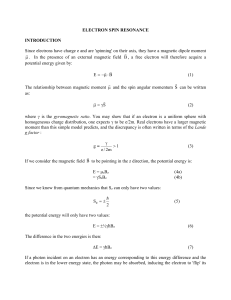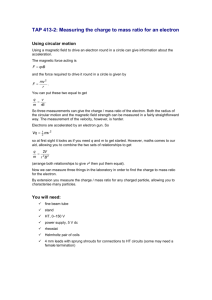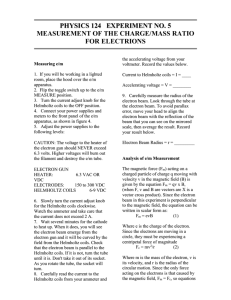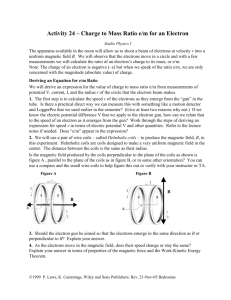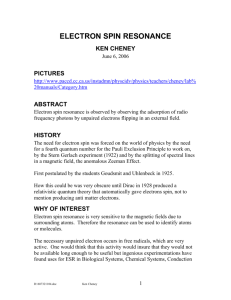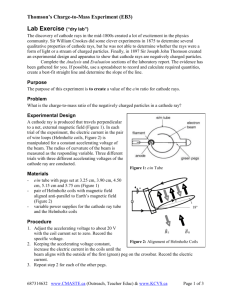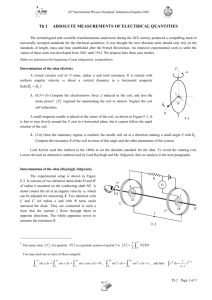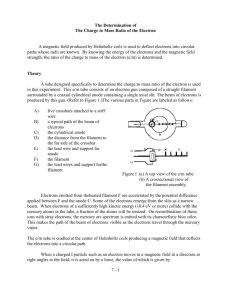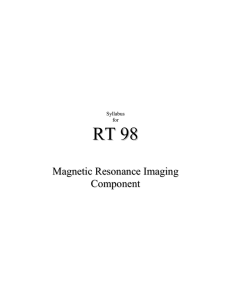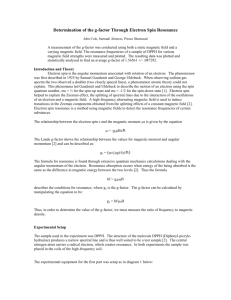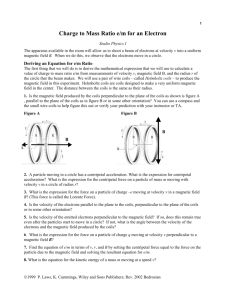ELECTRON SPIN RESONANCE
advertisement
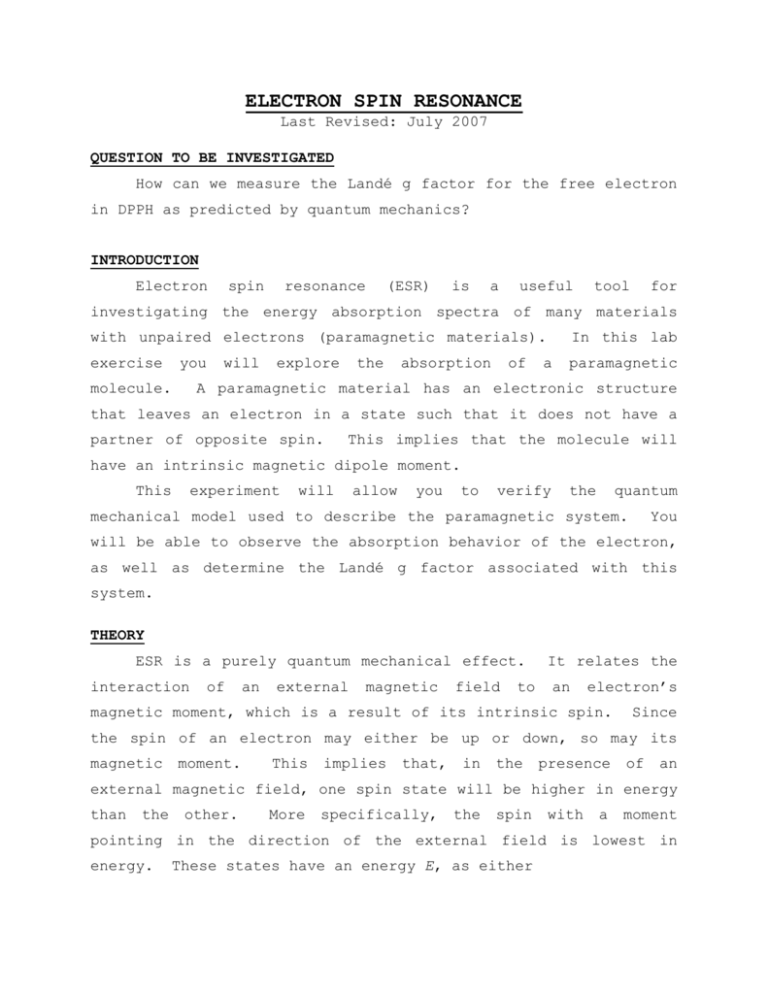
ELECTRON SPIN RESONANCE Last Revised: July 2007 QUESTION TO BE INVESTIGATED How can we measure the Landé g factor for the free electron in DPPH as predicted by quantum mechanics? INTRODUCTION Electron spin resonance (ESR) is a useful tool for investigating the energy absorption spectra of many materials with unpaired electrons (paramagnetic materials). In this lab exercise paramagnetic you molecule. will explore the absorption of a A paramagnetic material has an electronic structure that leaves an electron in a state such that it does not have a partner of opposite spin. This implies that the molecule will have an intrinsic magnetic dipole moment. This experiment will allow you to verify the quantum mechanical model used to describe the paramagnetic system. You will be able to observe the absorption behavior of the electron, as well as determine the Landé g factor associated with this system. THEORY ESR is a purely quantum mechanical effect. interaction of an external magnetic field to It relates the an electron’s magnetic moment, which is a result of its intrinsic spin. Since the spin of an electron may either be up or down, so may its magnetic moment. This implies that, in the presence of an external magnetic field, one spin state will be higher in energy than the other. More specifically, the spin with a moment pointing in the direction of the external field is lowest in energy. These states have an energy E, as either (1) Where g is the Lande’ factor, μB is the Bohr magneton (a constant), and B is the value of the external magnetic field. Thus, the change in energy from the negative to the positive spin state can be written (2) Therefore, because g and μB are constants, there are pairs of values of the energy E and of the external field B that satisfy Eq. (2) and result in a transition of spin states. At commonly attainable magnetic field strengths the corresponding energy lies in the radio-frequency (RF) regime. Where the general expression for the energy of a photon applies (3) Where E is the energy of an RF photon, h is Plank’s constant, and is the frequency of the photon. When a photon of energy E is incident on an electron in a field of strength B electron resonance will be observed. EXPERIMENT The electrons that you will manipulate are located in the paramagnetic molecule Diphenyl-Picryl-Hydrazyl (DPPH). pictured below; notice the unpaired electron. also very weakly bound to the nitrogen atom. DPPH is This electron is The combination of these two properties makes this molecule ideal for studying the magnetic properties of the electron. The DPPH has been loaded onto a piece of cotton and placed inside of a sample tube. The sample tube should then be placed in a coil and inserted into the mount (light grey cylinder in Figure 2). Consult the manufacturer’s manual for any necessary information concerning setup this device. of the Figure 1. Sketch of the structure of a DPPH molecule showing the nitrogen (N) contributing the “free” electron. Figure 2 shows a block diagram depicting the experimental setup. There are essentially two circuits: The first controls and monitors the RF signal driving of the electrons (at left), and the second controls the external magnetic field (right). You should observe the output of the absorption of the DPPH on 12 V - G + -G+ IN Ch1 Ch2 RF Freq. 12 V + G - OUT (BNC ) T Amp R~1ÉŽ Figure 2. A drawing of the basic elements of the experiment is shown. The circuit is also shown. one channel of the oscilloscope (DC couple the o-scope channel) and the voltage across the resistor on the other channel. The frequency of the RF input can be selected by a knob located on the top of the sample-mount box. This box also contains a bridge circuit to amplify the absorption signal and cancel out the electronics resonance effects. The second circuit controls the current running through the Helmholtz coils, and consequently the external magnetic field. A special voltage source is to be used which applies a ramped signal with a long whose period. This frequency, signal sign, and is one-half amplitude of you a triangle wave, may adjust. You should observe the half triangle on the remaining oscilloscope channel by monitoring the voltage drop across the 1Ω resistor in this circuit (see Figure 2). Observing these two signals will allow you to correlate the occurrence of resonance to the value of the external B field. The purpose of the resistor is to limit the current in the circuit and allow you to observe the signal on the oscilloscope. A measurement of the resistor’s value and the oscilloscope trace will allow you to calculate the current in the coils at any given time. As the voltage increases from the triangular current source so does the current running through the coils, which in turn creates the desired magnetic field around the sample. At a specific value of this field (see Eq. 2) resonance will occur and you will see a very obvious dip in the output of the RF device. You will see two symmetrical dips, one as the B field ramps up through the value specified by Eq. 2 and another as it descends through this same value. These dips occur because the electrons are absorbing some of the photons. If you ramp the field too quickly the peaks will not be symmetric. explain why this happens? Can you Choose a repetition rate and ramping period such that the during the ramps. entire shape of the resonance is seen It may take some practice to achieve the right shape and repetition rate for the ramp. A uniform magnetic field can be reasonably achieved using Helmholtz coils. Helmholtz coils are composed of two coaxial coils of wire separated by a distance equal to their radii. A derivation of the field from two coils in the Helmholtz configuration is in the Appendix. Each coil should have the same number of windings and the same radius. The coils should also have the same current running through them (wired in series, Figure 2). When all of these conditions are met there will be a volume of nearly uniform field within the coils. Use the Gaussmeter to prove that the field is uniform over the length of the sample. How do you think variations in the field will effect the resonance of the sample’s electrons? At this time you should pause and become more familiar with the oscilloscope’s functions; the manual has been provided on the course website. In addition to the normal voltage and time range adjustments, you will need to understand how to export data to an external disk. Take resonance data for at least 4 different frequencies of RF radiation. You may wish to utilize the oscilloscopes averaging function in order to reduce noise. Magnetic Field Calibration: To use Eq. (2) you will need to know the value of the magnetic field where absorption occurs. This may be accomplished by using a Gaussmeter. A Gaussmeter is a long thin probe that measures the value of a magnetic field via the Hall Effect (which you may explore in another experiment). the DPPH sample and place the probe inside the coils. observe the Gaussmeter’s read-out on the Remove You can oscilloscope while simultaneously watching the triangle wave on another channel. This will allow you to create an expression for B as a function of time, or to simply correlate individual values to true magnetic field strengths. You must also measure the uniformity of the magnetic field. Remove the sample and measure the field in a horizontal line starting 2cm behind the center of the coils to 2cm in front of the coils in 2mm steps. Do the same for a vertical line starting 1 cm below the center and ending 1cm above the center in steps of 2mm. From each of the data sets, fit a smooth curve to the field vs. position. Measure the size of the sample. Using the fit curve, average the field over the length of the sample. Repeat for the vertical thickness of the sample. Do not include the glass thickness in your averages. Divide the results by the field at the center of the target. These will be correction factors that you will need to use in calculating g. Resonance Data Analysis: To get the value of the field at resonance take your recorded data and fit a gaussian plus background to your peak. Fit only the voltage values in the vicinity of the peak. Do not try to fit the full peak shape as it is not gaussian. The centroid of the gaussian is the time at which the resonance was maximum. Use the chisquare of the fit to determine the approximate uncertainty in the position of the centroid. Use your frequencies and the measured field of resonance to calculate the Lande’ g factor and its error. Report: You should report: - The value of the resistor each - The field vs. current calibration fit (plot required) - The field vs. distance curve and fits (plot required) - The correction factors - A fit of resonance curve you used to arrive at a value for the magnet current (plot required) - The value of the Lande’ g factor (nominal = 2.0036) for this system and its error. - The variation in the magnetic field over the area of the DPPH sample. As you have seen, the absorption appears as symmetrical dips in an otherwise constant signal. However, anomalous behavior has been observed when the frequency of the B field source is very low. trailing the We have seen the signal develop a spike typical absorption waveform, which higher magnitude than the standard baseline. is of much This phenomenon has not been fully investigated, but appears to be intrinsic to this particular system. There are several theories. One identifies the culprit as an unwanted behavior of the current power supply. the sample Another theory is that there are resonances in mount that were not frequencies of the B field current. corrected for at lower You should investigate this behavior, as it is an excellent example of the fact that all experimental setups have limitations and behaviors that deviate from theory. Determine the maximum field at which this behavior occurs and make sure that your field values are above this. Report the maximum current where this effect is seen. treatment of this issue in your discussion. Provide a Appendix: Helmholtz Derivation We wish to derive an expression for the strength of the magnetic field B along the axis of a pair of Helmholtz coils. We begin with the expression for the magnetic field of a single loop along the axis running through the loop (from the Biot-Savart Law): where μ0 is the permeability of the vacuum, I is the current through the loop, R is the radius of the coil, and x is any coordinate along the axis of the two coils. However, our Helmholtz coils are not single coils, but consist of n number of single turns, thus yielding: We will place our sample halfway inbetween the two coils. This sets x to R/2, because Helmholtz coils are separated by a distance equal to their radius. This substitution yields: Also, there are two coils so we must double our expression: Thus, our powers of algebra have led us to a useful result: Extension: If I = I(t) then you may also may achieve B(I,R,t).
